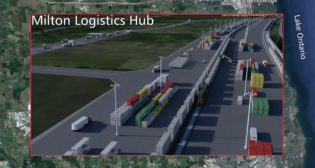
CP-NS transcon a craps table roll
Written by Frank N. Wilner, Capitol Hill Contributing EditorFew obstacles bedevil railroads as has the Mississippi River. Spanning it was the nation’s first rail bridge in 1856—promptly assaulted by steamboat Effie Afton. While the bridge was repaired and more constructed, the river remains a problematic divide, separating, with few exceptions, eastern railroads from those operating in the West and producing grueling interchange bottlenecks at Chicago.
Whether single-line transcons encompassing U.S. railroads is a solution prompts spirited debate. For dissimilar reasons, past transcon efforts failed—Seaboard Coast Line (now part of CSX) with Southern Pacific (now part of Union Pacific); BNSF with Canadian National (CN); and Canadian Pacific (CP) with CSX.
Dreamers remain, including 71-year-old Hunter Harrison, CP’s CEO—a brusque presence who has so improved productivity on the three railroads he superintended (Illinois Central, CN and CP) that comparisons are made with industrial engineering legend Frederick Taylor.
Whether Harrison will create a legacy rivaling 19th century titans James J. Hill, Collis Huntington and Cornelius Vanderbilt by securing regulatory approval to create the first North American transcon by hitching CP, end-to-end, with Norfolk Southern (NS), is unknown.
Notwithstanding pro-competitive features, formidable obstacles include skeptical CP stockholders, NS itself, other railroads, regulators, Congress and the new Canadian prime minister.
CP will pay an acquisition premium for NS stock, expecting a more than compensatory boost in NS profitability achieved by tamping down the NS operating ratio from near 70 to a target of 60. While end-to-end marriages lack easily jettisoned redundancies, and U.S. statutory protection impedes layoffs, Harrison has a proven model for squeezing the operating ratio—substituting high hourly pay, guaranteed days off, scheduled assignments, eliminating road and yard distinctions, and fixed crew-calling windows permitting a trimming of the work force through attrition, putting productivity on steroids while train and engine workers boost annual earnings as much as $30,000.
Harrison may be a Tennessee native, but among the clannish good ’ol boys running NS he is an in-your-face interloper at odds with their cherished courtly manners. Even assuming Harrison could succeed in wringing from NS consequential new productivity gains, he must travel south to do so, leaving CP investors bereft of the precise CP managerial direction deemed so valuable.
Then there is Harrison’s willingness, in exchange for merger approval, to provide a pro-competitive lagniappe of track access (reciprocal switching) and bottleneck pricing at sole-served U.S. points. Shippers crave it; Canada requires it; U.S. railroads, rich with political influence, stalwartly oppose it.
The Surface Transportation Board (STB), with sole authority over rail mergers, may be independent of direct political influence, but STB members seeking new terms require Senate confirmation, the STB budget requires congressional approval, and a merger-averse Congress could amend the statute—transferring rail merger authority to the merger-cynical Department of Justice; or enacting Senate Commerce Committee Chairman John Thune’s (R-S.Dak.) bill to increase STB size by two voting members, maybe selected with a “no merger” vote in mind.
In June, amidst widespread service disruptions, STB member Deb Miller expressed “no appetite” for a merger application. Notwithstanding expected CP assurances of a seamless merger, history is littered with significant unanticipated post-merger service disruptions. Coincidentally, CP President Keith Creel visited with STB members individually Nov. 4 in Washington. Two days later, the CP-NS story broke.
STB merger rules require consideration of anticipated responsive merger applications and their potential impact on competition and service—perhaps CN with BNSF, and Union Pacific with CSX creating the long-sought wholly U.S. transcon.
With whom will Kansas City Southern (KCS)—operating north-south into Mexico—join? Harrison and KCS CEO David Starling trace roots to St. Louis-San Francisco Railway (the Frisco, now part of BNSF) and later interacted as Burlington Northern operating officials.
In Ottawa, the Canadian prime minister holds absolute power to nix rail mergers. As CP-NS would strengthen CP as an international logistics giant at the expense of CN, the latter might invoke, in opposition, its own formidable political muscle. CN already is pursuing a corporate espionage lawsuit against CP.
An interim voting trust allows CP to consummate the financial transaction ahead of merger. NS stockholders receive their premium plus CP shares. Blocked is a bidding war for NS by UP or Berkshire Hathaway. Voting trusts need STB approval. A jiggery-pokery attempt to send Creel to NS and NS CEO Jim Squires to CP may backfire as improper common control.
As Pollyanna and Cassandra wished each other, “May you live in interesting times.”



